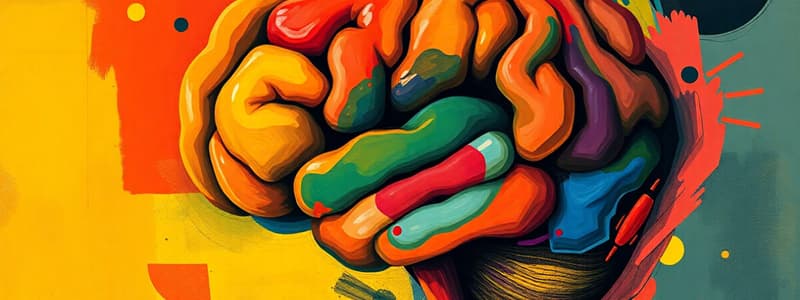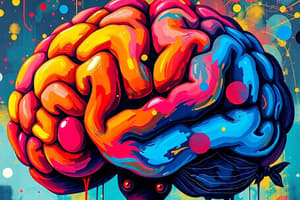Podcast
Questions and Answers
The ______ controls conscious thoughts, personality, reasoning, language, and memory.
The ______ controls conscious thoughts, personality, reasoning, language, and memory.
cerebrum
The ______ regulates emotions, particularly fear.
The ______ regulates emotions, particularly fear.
amygdala
The main parts of a light microscope include light, stage, eyepiece lens, and ______ lenses.
The main parts of a light microscope include light, stage, eyepiece lens, and ______ lenses.
objective
A ______ is an explanation you can test, which includes a reason and a 'science idea'.
A ______ is an explanation you can test, which includes a reason and a 'science idea'.
In an experiment, the ______ variable is what you change to see how it affects the dependent variable.
In an experiment, the ______ variable is what you change to see how it affects the dependent variable.
The ______ variable is what you measure or observe in an investigation.
The ______ variable is what you measure or observe in an investigation.
To calculate magnification, you multiply the eyepiece lens power by the ______ lens power.
To calculate magnification, you multiply the eyepiece lens power by the ______ lens power.
Both plant and animal cells have a cell membrane, nucleus, cytoplasm, and ______.
Both plant and animal cells have a cell membrane, nucleus, cytoplasm, and ______.
The ______ controls balance, posture, and coordination of movement.
The ______ controls balance, posture, and coordination of movement.
The ______ is responsible for the formation of long-term memories.
The ______ is responsible for the formation of long-term memories.
______ are strategies that allow material to be held for longer in short-term memory.
______ are strategies that allow material to be held for longer in short-term memory.
In Miller's Law, short-term memory can hold around ______ items.
In Miller's Law, short-term memory can hold around ______ items.
The ______ effect explains why we are more likely to remember the first and last items in a list.
The ______ effect explains why we are more likely to remember the first and last items in a list.
A ______ variable remains unchanged to prevent it from affecting the dependent variable in an experiment.
A ______ variable remains unchanged to prevent it from affecting the dependent variable in an experiment.
The structure and function of _____ cells include muscle, sperm, and nerve cells.
The structure and function of _____ cells include muscle, sperm, and nerve cells.
Plant cells uniquely have a ______ and chloroplasts that are not found in animal cells.
Plant cells uniquely have a ______ and chloroplasts that are not found in animal cells.
Flashcards are hidden until you start studying
Study Notes
The Brain and its Functions
- Cerebrum: Controls conscious thoughts, personality, reasoning, language, and memory.
- Cerebellum: Controls balance, posture, coordination of movement, and muscular activity.
- Medulla: Controls unconscious activities like heart and breathing rate.
- Amygdala: Regulates emotions, especially fear.
- Hippocampus: Formation of long-term memories.
- Hypothalamus: Controls body temperature and water balance.
- Thalamus: Filters sensory information, determining what gets passed on to the cerebrum.
Short-Term Memory
- Miller’s Law: Short-term memory has limited capacity and can only hold 7±2 items of information.
- Peterson & Peterson Experiment: Demonstrated the duration of Short-Term Memory.
Working Memory Model
- Baddely & Hitch's Working Memory Model proposes a system for temporarily holding and manipulating information.
- Rehearsal Strategies: Help maintain material in short-term memory longer.
- Chunking: Grouping information into meaningful units to enhance memory capacity.
- Mnemonics: Memory aids or techniques that use association, imagery, or other strategies to improve retention.
- Primary-Recency Effect: We remember the first and last things we hear or learn about better.
Light Microscopy
- Components: Light source, stage, eyepiece lens, objective lenses, coarse focusing wheel, fine focusing wheel.
- Magnification Calculation: Eyepiece lens power x objective lens power.
Cell Structure
- Animal Cells: Have a cell membrane, nucleus, cytoplasm, and mitochondria.
- Plant Cells: Have a cell membrane, nucleus, cytoplasm, mitochondria, cell wall, chloroplasts, and usually a permanent vacuole.
Scientific Investigation
- Hypothesis: A testable explanation that includes a reason and a scientific idea.
- Prediction: What you think will happen in an experiment.
- Independent Variable: What you change in an investigation (to observe its effect on the dependent variable).
- Dependent Variable: What you measure or observe in an investigation.
- Control Variable: Remains unchanged or held constant to prevent it from influencing the dependent variable.
- Practical Skills:
- Making temporary slides
- Setting up and focusing a light microscope
- Producing a biological drawing
- Identifying dependent and independent variables
- Listing all variables that could affect the dependent variable
Specialist Cells
- Animal Cells:
- Muscle Cells: Contraction for movement.
- Sperm Cells: Fertilization of eggs.
- Nerve Cells: Transmission of nerve impulses.
- Plant Cells:
- Root Hair Cells: Absorption of water and minerals.
- Xylem: Transport of water throughout the plant.
- Phloem: Transport of sugars throughout the plant.
The Brain
- Cerebrum: Controls conscious thoughts, personality, reasoning, language and memory.
- Cerebellum: controls balance, posture, coordination of movement & muscular activity.
- Medulla: controls unconscious activities such as heart and breathing rate.
- Amygdala: regulation of emotions, particularly fear.
- Hippocampus: Formation of long-term memories.
- Hypothalamus: control of body temperature and water balance.
- Thalamus: Sensory filtering, determining what information is passed on to the cerebrum.
Short-Term Memory
- Miller’s Law: short-term memory has limited capacity and can only hold 7+2 items of information.
- Peterson And Peterson Experiment: Demonstrated the duration of short-term memory.
- Working memory Model (Baddely & Hitch): This model describes how short-term memory works.
- Rehearsal strategies allow material to be held for longer in the STM:
- Chunking
- Mnemonics
- Primary-Recency effect: We are more likely to remember the first and last things we hear / learn about.
Light Microscopes
- Key parts include:
- Light source
- Stage
- Eyepiece lens
- Objective lenses
- Course focusing wheel
- Fine focusing wheel
- Magnification calculation: eyepiece lens power x objective lens power
Cells
- Both plant and animal cells have a cell membrane, nucleus, cytoplasm, and mitochondria.
- Plant cells also have a cell wall, chloroplasts, and usually a permanent vacuole.
Scientific Method
- Hypothesis: An explanation you can test which includes a reason and a 'science idea'.
- Prediction: What you think will happen in an experiment.
- Independent variable: What you change in an investigation (to see how it affects the dependent variable).
- Dependent variable: What you measure or observe in an investigation.
- Control variable: One that remains unchanged to stop it affecting the dependent variable.
Practical Skills
- How to make a temporary slide
- How to set up and focus a light microscope
- How to produce a biological drawing
- Identifying the dependent variable
- Identifying the independent variable
- Listing all the variables that could affect the dependent variable
Specialist cells
- Animal:
- Muscle cell: Structure and function
- Sperm cell: Structure and function
- Nerve cell: Structure and function
- Plant:
- Root hair cell: Structure and function
- Xylem: Structure and function
- Phloem: Structure and function
Studying That Suits You
Use AI to generate personalized quizzes and flashcards to suit your learning preferences.



